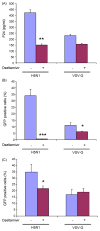Characterization of a trypsin-dependent avian influenza H5N1-pseudotyped HIV vector system for high throughput screening of inhibitory molecules
- PMID: 18359097
- PMCID: PMC5123875
- DOI: 10.1016/j.antiviral.2008.02.001
Characterization of a trypsin-dependent avian influenza H5N1-pseudotyped HIV vector system for high throughput screening of inhibitory molecules
Abstract
In this study, we have generated and characterized an avian influenza H5N1 hemagglutinin (HA), neuraminidase (NA) and M2 ion channel pseudotyped HIV-based vector system (HaNaM-pseudotyped HIV vector). The cleavage site of the HA protein was modified to necessitate trypsin-dependent maturation of the glycoprotein. HA, NA and M2 were efficiently incorporated in HIV vector particles which could transduce different cell lines in a trypsin-dependent manner. Results also showed that the presence of avian influenza M2 and NA proteins maximized both vector production and transduction and that transduction was highly sensitive to the specific NA inhibitor oseltamivir (Tamiflu). H5N1 HaNaM-pseudotyped HIV vector system was also adapted for cell-based high throughput screening of drug candidates against influenza virus infection, and its high sensitivity to the specific oseltamivir validates its potential utility in the identification of new influenza inhibitors. Overall, the trypsin-dependent H5N1-pseudotyped HIV vector can mimic avian influenza virus infection processes with sufficient precision to allow for the identification of new antivirals and to study avian influenza virus biology in a lower biosafety level laboratory environment.
Figures





References
-
- Ao Z, Huang G, Yao H, Xu Z, Labine M, Cochrane AW, Yao X. Interaction of human immunodeficiency virus type 1 integrase with cellular nuclear import receptor importin 7 and its impact on viral replication. J Biol Chem. 2007;282:13456–13467. - PubMed
-
- Bright RA, Medina MJ, Xu X, Perez-Oronoz G, Wallis TR, Davis XM, Povinelli L, Cox NJ, Klimov AI. Incidence of adamantane resistance among influenza A (H3N2) viruses isolated worldwide from 1994 to 2005: a cause for concern. Lancet. 2005;366:1175–1181. - PubMed
-
- Cheung CL, Rayner JM, Smith GJ, Wang P, Naipospos TS, Zhang J, Yuen KY, Webster RG, Peiris JS, Guan Y, Chen H. Distribution of amantadine-resistant H5N1 avian influenza variants in Asia. J Infect Dis. 2006;193:1626–1629. - PubMed
-
- Ferguson NM, Cummings DA, Cauchemez S, Fraser C, Riley S, Meeiyai A, Iamsirithaworn S, Burke DS. Strategies for containing an emerging influenza pandemic in Southeast Asia. Nature. 2005;437:209–214. - PubMed
Publication types
MeSH terms
Substances
Grants and funding
LinkOut - more resources
Full Text Sources
Other Literature Sources
Medical

